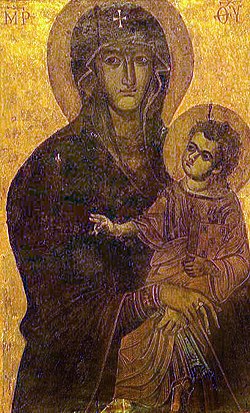This article has multiple issues. Please help improve it or discuss these issues on the talk page. (Learn how and when to remove these messages)
|



Luca Cancellari (Luke Cangellaris; Greek: Λουκάς Καγκελλάρης) is a Byzantine icon painter posited in some modern Greek encyclopaedias to have lived during the 12th century in Constantinople, where he painted some of the best icons of Virgin Mary. These works ascribe him the creation of icons like the Madonna Nicopeia in St Mark's Basilica, that ended up in Venice after the conquest of Constantinople by the Crusaders in 1204, the Madonna di San Luca in the namesake Sanctuary, transferred in Bologna in 1160 and bearing the inscription Opus Lucae Cancellari, or as read by Antonio Masini (1599-1691) Cancellarii, the Madonna Salus Populi Romani in the Basilica di Santa Maria Maggiore in Rome and other with Greek inscriptions of that period.
Giovanni Lami, who strongly opposed that Saint Luke the Evangelist was a painter, thought that the icon of Madonna di San Luca was executed by a certain Luca Santo, a Florentin painter of the 14th century. He alleged that Luca Santo was the son of a nominated Cancelliere and considered improbable the claim that this icon was brought from Constantinople.
Although a direct genealogical connection is not possible due to lack of sources prior to the 15th century in Greece, it is recorded that following the conquest of Constantinople by the Ottomans (1453) the Cangelari family name (in Greek: Καγγελάρης, Καγκελάρης or Καγκελλάρης) is traced in the island of Corfu, where from its members migrated to Cephalonia (early 16th century), Santa Maura (late 17th century) (Ionian Islands) and other parts of mainland Greece and the diaspora.
References
- Eleftheroudakis 1929, vol.7, p.21
- Helios 1977, vol.11, p.139
- Haris Patsis 1980, vol.18, p.579
- Zani 1817-28, vol.XII (1822), annotation 36, p.169
- Zani 1817-28, vol.XII (1822), annotation 36, p.169-70
- Boskovits 1994, p.203
- Lami's view is mentioned by professor Cole at Cole 1996, p.127
- Cangelaris 2011, p.51, ftn.2
Sources
- Pietro Zani, Enciclopedia Metodica Critico-Ragionata delle Arte, Parma 1817-28 (in Italian)
- Eleftheroudakis Encyclopedia, Athens 1929 (in Greek)
- Helios Newest Encyclopedia, Athens 1977 (in Greek)
- Haris Patsis New Grand Hellenic Encyclopedia, Athens 1980 (in Greek)
- Miklós Boskovits, A Corpus of Florentine Painting - The Origins of Florentine Painting 1100-1270, Florence 1994
- Bruce Cole, Studies in the history of Italian art 1250-1550, New York 1996
- P.D.Cangelaris "History and Genealogy of the Cangelari Family of Cephalonia (16th-20th Centuries)", Corfu 2011 (in Greek) ISBN 978-960-85532-2-4